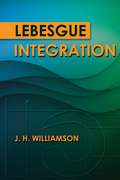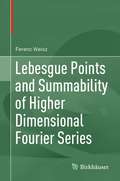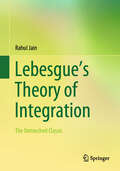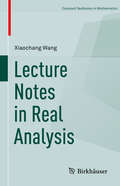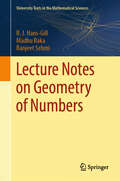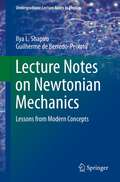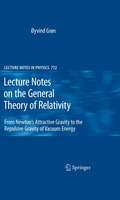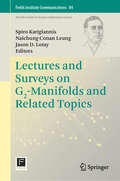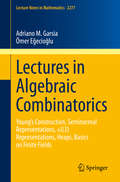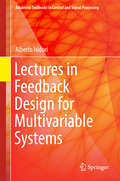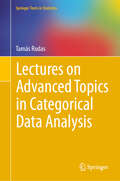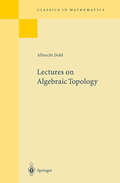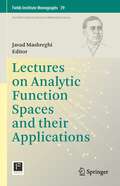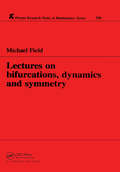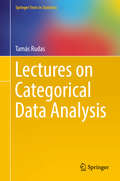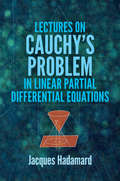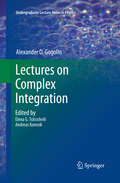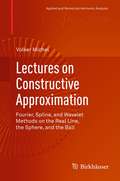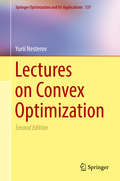- Table View
- List View
Lebesgue Integration (Dover Books on Mathematics)
by J. H. WilliamsonThis concise introduction to Lebesgue integration is geared toward advanced undergraduate math majors and may be read by any student possessing some familiarity with real variable theory and elementary calculus. The self-contained treatment features exercises at the end of each chapter that range from simple to difficult. The approach begins with sets and functions and advances to Lebesgue measure, including considerations of measurable sets, sets of measure zero, and Borel sets and nonmeasurable sets. A two-part exploration of the integral covers measurable functions, convergence theorems, convergence in mean, Fourier theory, and other topics. A chapter on calculus examines change of variables, differentiation of integrals, and integration of derivatives and by parts. The text concludes with a consideration of more general measures, including absolute continuity and convolution products.
Lebesgue Points and Summability of Higher Dimensional Fourier Series
by Ferenc WeiszThis monograph presents the summability of higher dimensional Fourier series, and generalizes the concept of Lebesgue points. Focusing on Fejér and Cesàro summability, as well as theta-summation, readers will become more familiar with a wide variety of summability methods. Within the theory of higher dimensional summability of Fourier series, the book also provides a much-needed simple proof of Lebesgue’s theorem, filling a gap in the literature. Recent results and real-world applications are highlighted as well, making this a timely resource. The book is structured into four chapters, prioritizing clarity throughout. Chapter One covers basic results from the one-dimensional Fourier series, and offers a clear proof of the Lebesgue theorem. In Chapter Two, convergence and boundedness results for the lq-summability are presented. The restricted and unrestricted rectangular summability are provided in Chapter Three, as well as the sufficient and necessary condition for the norm convergence of the rectangular theta-means. Chapter Four then introduces six types of Lebesgue points for higher dimensional functions. Lebesgue Points and Summability of Higher Dimensional Fourier Series will appeal to researchers working in mathematical analysis, particularly those interested in Fourier and harmonic analysis. Researchers in applied fields will also find this useful.
Lebesgue’s Theory of Integration: The Untouched Classic
by Rahul JainThis is an invaluable book that presents the original work published in French, in 1904, by Henry Leon Lebesgue, the creator of the theory of integration. Translated into English for the first time, the book offers readers a unique opportunity to explore Lebesgue’s groundbreaking ideas and delves into the mind of one of the greatest mathematicians in history. The book provides historical context and explanations that enhance readers’ comprehension and appreciation of the material. Covering a wide range of topics, from the integration before Riemann to the search for primitive functions, it offers a comprehensive understanding of Lebesgue’s theories and their significance in the field of mathematics. It inspires readers to explore further in the field, stimulates new ideas, and opens avenues for future research. The book bridges the gap between theory and practice by providing examples and applications that contributed to the development of Lebesgue integration theory. The book serves as a valuable resource for courses in analysis, measure theory, and Lebesgue integration theory, providing students with the opportunity to study the original work of Lebesgue and deepen their understanding of integration theory. It is meant for a broad audience, including advanced undergraduate and graduate students, mathematics scholars, researchers, educators, and enthusiasts, seeking a comprehensive understanding of Lebesgue’s theories and the historical development of integration theory. Mathematicians and researchers will find this book essential for its historical significance and the preservation of important mathematical literature.
Lecture Notes in Real Analysis (Compact Textbooks in Mathematics)
by Xiaochang WangThis compact textbook is a collection of the author’s lecture notes for a two-semester graduate-level real analysis course. While the material covered is standard, the author’s approach is unique in that it combines elements from both Royden’s and Folland’s classic texts to provide a more concise and intuitive presentation. Illustrations, examples, and exercises are included that present Lebesgue integrals, measure theory, and topological spaces in an original and more accessible way, making difficult concepts easier for students to understand. This text can be used as a supplementary resource or for individual study.
Lecture Notes on Geometry of Numbers (University Texts in the Mathematical Sciences)
by R. J. Hans-Gill Madhu Raka Ranjeet SehmiThis book serves as an illuminating introduction to the intricacies of the geometry of numbers. It commences by exploring basic concepts of convex sets and lattices in Euclidean space and goes on to delve into Minkowski’s fundamental theorem for convex bodies and its applications. It discusses critical determinants and successive minima before explaining the core results of packings and coverings. The text goes on to delve into the significance of renowned conjectures such as Minkowski’s conjecture regarding the product of linear forms, Watson’s conjecture, and the conjecture of Bambah, Dumir, and Hans-Gill concerning non-homogeneous minima of indefinite quadratic forms. Dedicated to Prof. R.P. Bambah on his 98th birthday, a living legend of number theory in India, this comprehensive book addresses both homogeneous and non-homogeneous problems, while sprinkling in historical insights and highlighting unresolved questions in the field. It is ideally suited for beginnersembarking on self-study as well as for use as a text for a one- or two-semester introductory course.
Lecture Notes on Newtonian Mechanics: Lessons from Modern Concepts
by Guilherme de Berredo-Peixoto Ilya L. ShapiroOne could make the claim that all branches of physics are basically generalizations of classical mechanics. It is also often the first course which is taught to physics students. The approach of this book is to construct an intermediate discipline between general courses of physics and analytical mechanics, using more sophisticated mathematical tools. The aim of this book is to prepare a self-consistent and compact text that is very useful for teachers as well as for independent study.
Lecture Notes on Numerical Methods for Hyperbolic Equations
by Elena Vázquez-CendónThis volume contains the lecture notes of the Short Course on Numerical Methods for Hyperbolic Equations (Faculty of Mathematics, University of Santiago de Compostela, Spain, 2-4 July 2011). The course was organized in recognition of Prof. Eleuterio Toro‘s contribution to education and training on numerical methods for partial differential equation
Lecture Notes on the General Theory of Relativity
by Øyvind GrønThis book is the result of more than twenty years of lecturing a master course on the General Theory of Relativity at the University of Oslo, Norway, by Dr. Øyvind Grøn. The text has been continuously updated by Dr. Grøn and is written so students can follow the deductions all the way throughout the book. The conceptual content of the general theory of relativity is presented briefly but reasonably and completely. Both bachelor students and master students will find the text useful as the manuscript is organized to easily find the topics one wants to read about, with separate lists of contents, figures, definitions, examples, and an index.
Lecture Notes: Epidemiology, Evidence-based Medicine and Public Health (Lecture Notes)
by Yoav Ben-Shlomo Sara Brookes Matthew HickmanTranslating the evidence from the bedside to populations This sixth edition of the best-selling Epidemiology, Evidence-based Medicine and Public Health Lecture Notes equips students and health professionals with the basic tools required to learn, practice and teach epidemiology and health prevention in a contemporary setting. The first section, ‘Epidemiology’, introduces the fundamental principles and scientific basis behind work to improve the health of populations, including a new chapter on genetic epidemiology. Applying the current and best scientific evidence to treatment at both individual and population level is intrinsically linked to epidemiology and public health, and has been introduced in a brand new second section: ‘Evidence-based Medicine’ (EBM), with advice on how to incorporate EBM principles into your own practice. The third section, 'Public Health', introduces students to public health practice, including strategies and tools used to prevent disease, prolong life, reduce inequalities, and includes global health. Thoroughly updated throughout, including new studies and cases from around the globe, key learning features include: Learning objectives and key points in every chapter Extended coverage of critical appraisal and data interpretation A brand new self-assessment section of SAQs and ’True/False’ questions for each topic A glossary to quickly identify the meaning of key terms, all of which are highlighted for study and exam preparation Further reading suggestions on each topic Whether approaching these topics for the first time, starting a special study module or placement, or looking for a quick-reference summary, this book offers medical students, junior doctors, and public health students an invaluable collection of theoretical and practical information.
Lectures and Surveys on G2-Manifolds and Related Topics (Fields Institute Communications #84)
by Spiro Karigiannis Naichung Conan Leung Jason D. LotayThis book, one of the first on G2 manifolds in decades, collects introductory lectures and survey articles largely based on talks given at a workshop held at the Fields Institute in August 2017, as part of the major thematic program on geometric analysis. It provides an accessible introduction to various aspects of the geometry of G2 manifolds, including the construction of examples, as well as the intimate relations with calibrated geometry, Yang-Mills gauge theory, and geometric flows. It also features the inclusion of a survey on the new topological and analytic invariants of G2 manifolds that have been recently discovered. The first half of the book, consisting of several introductory lectures, is aimed at experienced graduate students or early career researchers in geometry and topology who wish to familiarize themselves with this burgeoning field. The second half, consisting of numerous survey articles, is intended to be useful to both beginners and experts in the field.
Lectures in Algebraic Combinatorics: Young's Construction, Seminormal Representations, SL(2) Representations, Heaps, Basics on Finite Fields (Lecture Notes in Mathematics #2277)
by Adriano M. Garsia Ömer EğecioğluCapturing Adriano Garsia's unique perspective on essential topics in algebraic combinatorics, this book consists of selected, classic notes on a number of topics based on lectures held at the University of California, San Diego over the past few decades. The topics presented share a common theme of describing interesting interplays between algebraic topics such as representation theory and elegant structures which are sometimes thought of as being outside the purview of classical combinatorics. The lectures reflect Garsia’s inimitable narrative style and his exceptional expository ability. The preface presents the historical viewpoint as well as Garsia's personal insights into the subject matter. The lectures then start with a clear treatment of Alfred Young's construction of the irreducible representations of the symmetric group, seminormal representations and Morphy elements. This is followed by an elegant application of SL(2) representations to algebraic combinatorics. The last two lectures are on heaps, continued fractions and orthogonal polynomials with applications, and finally there is an exposition on the theory of finite fields. The book is aimed at graduate students and researchers in the field.
Lectures in Feedback Design for Multivariable Systems
by Alberto IsidoriThis book focuses on methods that relate, in one form or another, to the "small-gain theorem". It is aimed at readers who are interested in learning methods for the design of feedback laws for linear and nonlinear multivariable systems in the presence of model uncertainties. With worked examples throughout, it includes both introductory material and more advanced topics. Divided into two parts, the first covers relevant aspects of linear-systems theory, the second, nonlinear theory. In order to deepen readers' understanding, simpler single-input-single-output systems generally precede treatment of more complex multi-input-multi-output (MIMO) systems and linear systems precede nonlinear systems. This approach is used throughout, including in the final chapters, which explain the latest advanced ideas governing the stabilization, regulation, and tracking of nonlinear MIMO systems. Two major design problems are considered, both in the presence of model uncertainties: asymptotic stabilization with a "guaranteed region of attraction" of a given equilibrium point and asymptotic rejection of the effect of exogenous (disturbance) inputs on selected regulated outputs. Much of the introductory instructional material in this book has been developed for teaching students, while the final coverage of nonlinear MIMO systems offers readers a first coordinated treatment of completely novel results. The worked examples presented provide the instructor with ready-to-use material to help students to understand the mathematical theory. Readers should be familiar with the fundamentals of linear-systems and control theory. This book is a valuable resource for students following postgraduate programs in systems and control, as well as engineers working on the control of robotic, mechatronic and power systems.
Lectures in Knot Theory: An Exploration of Contemporary Topics (Universitext)
by Józef H. Przytycki Rhea Palak Bakshi Dionne Ibarra Gabriel Montoya-Vega Deborah WeeksThis text is based on lectures delivered by the first author on various, often nonstandard, parts of knot theory and related subjects. By exploring contemporary topics in knot theory including those that have become mainstream, such as skein modules, Khovanov homology and Gram determinants motivated by knots, this book offers an innovative extension to the existing literature. Each lecture begins with a historical overview of a topic and gives motivation for the development of that subject. Understanding of most of the material in the book requires only a basic knowledge of topology and abstract algebra. The intended audience is beginning and advanced graduate students, advanced undergraduate students, and researchers interested in knot theory and its relations with other disciplines within mathematics, physics, biology, and chemistry.Inclusion of many exercises, open problems, and conjectures enables the reader to enhance their understanding of the subject. The use of this text for the classroom is versatile and depends on the course level and choices made by the instructor. Suggestions for variations in course coverage are included in the Preface. The lecture style and array of topical coverage are hoped to inspire independent research and applications of the methods described in the book to other disciplines of science. An introduction to the topology of 3-dimensional manifolds is included in Appendices A and B. Lastly, Appendix C includes a Table of Knots.
Lectures in Projective Geometry (Dover Books on Mathematics)
by A. SeidenbergAn ideal text for undergraduate courses in projective geometry, this volume begins on familiar ground. It starts by employing the leading methods of projective geometry as an extension of high school-level studies of geometry and algebra, and proceeds to more advanced topics with an axiomatic approach.An introductory chapter leads to discussions of projective geometry's axiomatic foundations: establishing coordinates in a plane; relations between the basic theorems; higher-dimensional space; and conics. Additional topics include coordinate systems and linear transformations; an abstract consideration of coordinate systems; an analytical treatment of conic sections; coordinates on a conic; pairs of conics; quadric surfaces; and the Jordan canonical form. Numerous figures illuminate the text.
Lectures on Advanced Topics in Categorical Data Analysis (Springer Texts in Statistics)
by Tamás RudasThis book continues the mission of the previous text by the author, Lectures on Categorical Data Analysis, by expanding on the introductory concepts from that volume and providing a mathematically rigorous presentation of advanced topics and current research in statistical techniques which can be applied in the social, political, behavioral, and life sciences. It presents an intuitive and unified discussion of an array of themes in categorical data analysis, and the emphasis on structure over stochastics renders many of the methods applicable in machine learning environments and for the analysis of big data. The book focuses on graphical models, their application in causal analysis, the analytical properties of parameterizations of multivariate discrete distributions, marginal models, and coordinate-free relational models. To guide the readers in future research, the volume provides references to original papers and also offers detailed proofs of most of the significant results. Like the previous volume, it features exercises and research questions, making it appropriate for graduate students, as well as for active researchers.
Lectures on Algebraic Topology
by Albrecht DoldSpringer is reissuing a selected few highly successful books in a new, inexpensive softcover edition to make them easily accessible to younger generations of students and researchers. Springer-Verlag began publishing books in higher mathematics in 1920. This is a reprint of the Second Edition.
Lectures on Analytic Function Spaces and their Applications (Fields Institute Monographs #39)
by Javad MashreghiThe focus program on Analytic Function Spaces and their Applications took place at Fields Institute from July 1st to December 31st, 2021. Hilbert spaces of analytic functions form one of the pillars of complex analysis. These spaces have a rich structure and for more than a century have been studied by many prominent mathematicians. They have essential applications in other fields of mathematics and engineering. The most important Hilbert space of analytic functions is the Hardy class H2. However, its close cousins—the Bergman space A2, the Dirichlet space D, the model subspaces Kt, and the de Branges-Rovnyak spaces H(b)—have also garnered attention in recent decades. Leading experts on function spaces gathered and discussed new achievements and future venues of research on analytic function spaces, their operators, and their applications in other domains.With over 250 hours of lectures by prominent mathematicians, the program spanned a wide variety of topics. More explicitly, there were courses and workshops on Interpolation and Sampling, Riesz Bases, Frames and Signal Processing, Bounded Mean Oscillation, de Branges-Rovnyak Spaces, Blaschke Products and Inner Functions, and Convergence of Scattering Data and Non-linear Fourier Transform, among others. At the end of each week, there was a high-profile colloquium talk on the current topic. The program also contained two advanced courses on Schramm Loewner Evolution and Lattice Models and Reproducing Kernel Hilbert Space of Analytic Functions.This volume features the courses given on Hardy Spaces, Dirichlet Spaces, Bergman Spaces, Model Spaces, Operators on Function Spaces, Truncated Toeplitz Operators, Semigroups of weighted composition operators on spaces of holomorphic functions, the Corona Problem, Non-commutative Function Theory, and Drury-Arveson Space. This volume is a valuable resource for researchers interested in analytic function spaces.
Lectures on Bifurcations, Dynamics and Symmetry
by Michael J. FieldThis book is an expanded version of a Master Class on the symmetric bifurcation theory of differential equations given by the author at the University of Twente in 1995. The notes cover a wide range of recent results in the subject, and focus on the dynamics that can appear in the generic bifurcation theory of symmetric differential equations. This text covers a wide range of current results in the subject of bifurcations, dynamics and symmetry. The style and format of the original lectures has largely been maintained and the notes include over 70 exercises.
Lectures on Categorical Data Analysis
by Tamás RudasThis book offers a relatively self-contained presentation of the fundamental results in categorical data analysis, which plays a central role among the statistical techniques applied in the social, political and behavioral sciences, as well as in marketing and medical and biological research. The methods applied are mainly aimed at understanding the structure of associations among variables and the effects of other variables on these interactions. A great advantage of studying categorical data analysis is that many concepts in statistics become transparent when discussed in a categorical data context, and, in many places, the book takes this opportunity to comment on general principles and methods in statistics, addressing not only the “how” but also the “why.” Assuming minimal background in calculus, linear algebra, probability theory and statistics, the book is designed to be used in upper-undergraduate and graduate-level courses in the field and in more general statistical methodology courses, as well as a self-study resource for researchers and professionals. The book covers such key issues as: higher order interactions among categorical variables; the use of the delta-method to correctly determine asymptotic standard errors for complex quantities reported in surveys; the fundamentals of the main theories of causal analysis based on observational data; the usefulness of the odds ratio as a measure of association; and a detailed discussion of log-linear models, including graphical models. The book contains over 200 problems, many of which may also be used as starting points for undergraduate research projects. The material can be used by students toward a variety of goals, depending on the degree of theory or application desired.
Lectures on Cauchy's Problem in Linear Partial Differential Equations
by Jacques HadamardWould well repay study by most theoretical physicists." -- Physics Today"An overwhelming influence on subsequent work on the wave equation." -- Science Progress"One of the classical treatises on hyperbolic equations." -- Royal Naval Scientific ServiceDelivered at Columbia University and the Universities of Rome and Zürich, these lectures represent a pioneering investigation. Jacques Hadamard based his research on prior studies by Riemann, Kirchhoff, and Volterra. He extended and improved Volterra's work, applying its theories relating to spherical and cylindrical waves to all normal hyperbolic equations instead of only to one. Topics include the general properties of Cauchy's problem, the fundamental formula and the elementary solution, equations with an odd number of independent variables, and equations with an even number of independent variables and the method of descent.
Lectures on Classical Differential Geometry: Second Edition (Dover Books on Mathematics)
by Dirk J. StruikElementary, yet authoritative and scholarly, this book offers an excellent brief introduction to the classical theory of differential geometry. It is aimed at advanced undergraduate and graduate students who will find it not only highly readable but replete with illustrations carefully selected to help stimulate the student's visual understanding of geometry. The text features an abundance of problems, most of which are simple enough for class use, and often convey an interesting geometrical fact. A selection of more difficult problems has been included to challenge the ambitious student.Written by a noted mathematician and historian of mathematics, this volume presents the fundamental conceptions of the theory of curves and surfaces and applies them to a number of examples. Dr. Struik has enhanced the treatment with copious historical, biographical, and bibliographical references that place the theory in context and encourage the student to consult original sources and discover additional important ideas there.For this second edition, Professor Struik made some corrections and added an appendix with a sketch of the application of Cartan's method of Pfaffians to curve and surface theory. The result was to further increase the merit of this stimulating, thought-provoking text -- ideal for classroom use, but also perfectly suited for self-study. In this attractive, inexpensive paperback edition, it belongs in the library of any mathematician or student of mathematics interested in differential geometry.
Lectures on Complex Integration
by Alexander O. GogolinElena G. Tsitsishvili Andreas KomnikThe theory of complex functions is a strikingly beautiful and powerful area of mathematics. Some particularly fascinating examples are seemingly complicated integrals which are effortlessly computed after reshaping them into integrals along contours, as well as apparently difficult differential and integral equations, which can be elegantly solved using similar methods. To use them is sometimes routine but in many cases it borders on an art. The goal of the book is to introduce the reader to this beautiful area of mathematics and to teach him or her how to use these methods to solve a variety of problems ranging from computation of integrals to solving difficult integral equations. This is done with a help of numerous examples and problems with detailed solutions.
Lectures on Constructive Approximation
by Volker MichelLectures on Constructive Approximation: Fourier, Spline, and Wavelet Methods on the Real Line, the Sphere, and the Ball focuses on spherical problems as they occur in the geosciences and medical imaging. It comprises the author's lectures on classical approximation methods based on orthogonal polynomials and selected modern tools such as splines and wavelets. Methods for approximating functions on the real line are treated first, as they provide the foundations for the methods on the sphere and the ball and are useful for the analysis of time-dependent (spherical) problems. The author then examines the transfer of these spherical methods to problems on the ball, such as the modeling of the Earth's or the brain's interior. Specific topics covered include: * the advantages and disadvantages of Fourier, spline, and wavelet methods * theory and numerics of orthogonal polynomials on intervals, spheres, and balls * cubic splines and splines based on reproducing kernels * multiresolution analysis using wavelets and scaling functions This textbook is written for students in mathematics, physics, engineering, and the geosciences who have a basic background in analysis and linear algebra. The work may also be suitable as a self-study resource for researchers in the above-mentioned fields.
Lectures on Convex Geometry (Graduate Texts in Mathematics #286)
by Daniel Hug Wolfgang WeilThis book provides a self-contained introduction to convex geometry in Euclidean space. After covering the basic concepts and results, it develops Brunn–Minkowski theory, with an exposition of mixed volumes, the Brunn–Minkowski inequality, and some of its consequences, including the isoperimetric inequality. Further central topics are then treated, such as surface area measures, projection functions, zonoids, and geometric valuations. Finally, an introduction to integral-geometric formulas in Euclidean space is provided. The numerous exercises and the supplementary material at the end of each section form an essential part of the book. Convexity is an elementary and natural concept. It plays a key role in many mathematical fields, including functional analysis, optimization, probability theory, and stochastic geometry. Paving the way to the more advanced and specialized literature, the material will be accessible to students in the third year and can be covered in one semester.
Lectures on Convex Optimization: A Basic Course (Springer Optimization and Its Applications #137)
by Yurii NesterovThis book provides a comprehensive, modern introduction to convex optimization, a field that is becoming increasingly important in applied mathematics, economics and finance, engineering, and computer science, notably in data science and machine learning. Written by a leading expert in the field, this book includes recent advances in the algorithmic theory of convex optimization, naturally complementing the existing literature. It contains a unified and rigorous presentation of the acceleration techniques for minimization schemes of first- and second-order. It provides readers with a full treatment of the smoothing technique, which has tremendously extended the abilities of gradient-type methods. Several powerful approaches in structural optimization, including optimization in relative scale and polynomial-time interior-point methods, are also discussed in detail. Researchers in theoretical optimization as well as professionals working on optimization problems will find this book very useful. It presents many successful examples of how to develop very fast specialized minimization algorithms. Based on the author’s lectures, it can naturally serve as the basis for introductory and advanced courses in convex optimization for students in engineering, economics, computer science and mathematics.
